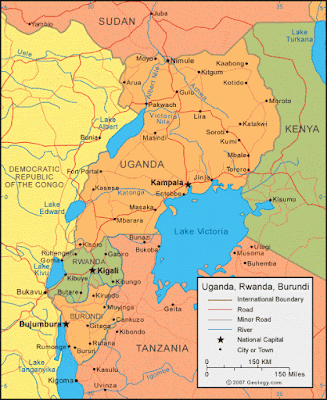Rwanda
Source: Geology.com
Source: Geology.com
Gatumba, situated
in the western region of the country, at around 25 km from the town of
Muhanga, is mineralized in cassiterite (tin ore), niobo-tantalite
(tantalum and niobium ore, locally called coltan), wolframite (tungsten
ore), tourmaline and several other secondary minerals such as beryl,
amblygonite, spodumene, apatite and Li-phosphates Mining activities were
initiated in Gatumba by the Belgium colonial companies and later on
were handed over in the 1970‟s to SOMIRWA (a joint venture between the
Government of Rwanda and private companies). In 1985 when SOMIRWA
declared bankruptcy, Gatumba as many other mines was kept unexploited
until 1989 when REDEMI (a Government owned company) was established to
relaunch mining activities. In 2006, the government privatized the
mining industry, and the Gatumba mining concession was acquired by a
private company, GMC (Gatumba Mining Concessions: a joint venture
between the Government and a consortium of private companies) which
exploited the Gatumba mines until May 2014 before leaving the mines
temporarily to artisanal mining sub-contractors. Minerals were mined
from alluvial, eluvial and pegmatites in open pits and tunnels.
Exploration was largely “exploration by exploitation”, however since
2009 pitting and trenching as well as limited drilling were undertaken.
The Exploration program from 2006 onward focused largely on five areas
within the former concession: Gatumba South (incorporating Bedeji),
Kirengo, Rukaragata_Nteresi, Nyabarongo South and
Mburabuturo-Busesamvuzo.
More than 250 pegmatites have been identified and/or mapped within the former concession area. About
130 larger pegmatite bodies have been identified and mapped by the
companies Minétain and Somirwa in the area between Rukaragata, Bijyoyo
and the Nyabarongo River.
The
pegmatites occur in four parallel networks between the granites. A
single network can be traced over a distance of more than 5 km (e.g.
Kirengo-Ruhanga- Gatumba-Kavumu). The dimension of the individual
pegmatites is quite variable. The thickness can vary between several
centimeters to 30 m and from tens of meters up to 2400 m in length.


